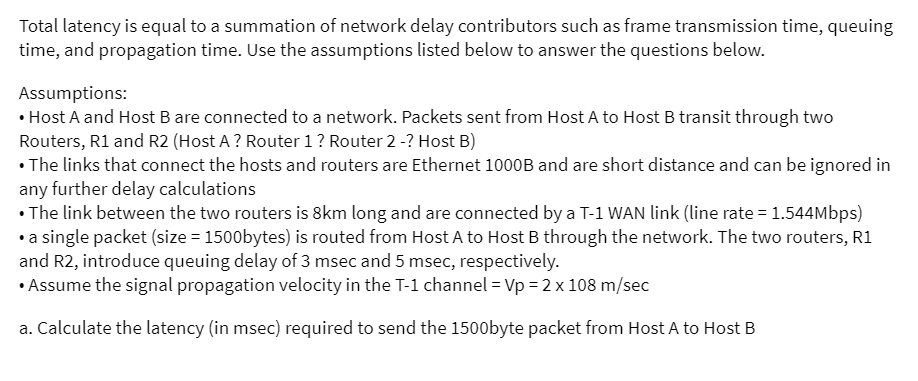Total latency is equal to a summation of network delay contributors such as frame transmission time, queuing time, and propagation time. Use the assumptions listed below to answer the questions below. Assumptions: • Host A and Host B are connected to a network. Packets sent from Host A to Host B transit through two Routers, R1 and R2 (Host A ? Router 1? Router 2 -? Host B) • The links that connect the hosts and routers are Ethernet 1000B and are short distance and can be ignored in any further delay calculations • The link between the two routers is 8km long and are connected by a T-1 WAN link (line rate = 1.544Mbps) • a single packet (size = 1500bytes) is routed from Host A to Host B through the network. The two routers, R1 and R2, introduce queuing delay of 3 msec and 5 msec, respectively. • Assume the signal propagation velocity in the T-1 channel = Vp = 2 x 108 m/sec a. Calculate the latency (in msec) required to send the 1500byte packet from Host A to Host B
Total latency is equal to a summation of network delay contributors such as frame transmission time, queuing time, and propagation time. Use the assumptions listed below to answer the questions below. Assumptions: • Host A and Host B are connected to a network. Packets sent from Host A to Host B transit through two Routers, R1 and R2 (Host A ? Router 1? Router 2 -? Host B) • The links that connect the hosts and routers are Ethernet 1000B and are short distance and can be ignored in any further delay calculations • The link between the two routers is 8km long and are connected by a T-1 WAN link (line rate = 1.544Mbps) • a single packet (size = 1500bytes) is routed from Host A to Host B through the network. The two routers, R1 and R2, introduce queuing delay of 3 msec and 5 msec, respectively. • Assume the signal propagation velocity in the T-1 channel = Vp = 2 x 108 m/sec a. Calculate the latency (in msec) required to send the 1500byte packet from Host A to Host B
Operations Research : Applications and Algorithms
4th Edition
ISBN:9780534380588
Author:Wayne L. Winston
Publisher:Wayne L. Winston
Chapter20: Queuing Theory
Section20.10: Exponential Queues In Series And Open Queuing Networks
Problem 8P
Related questions
Question
100%

Transcribed Image Text:Total latency is equal to a summation of network delay contributors such as frame transmission time, queuing
time, and propagation time. Use the assumptions listed below to answer the questions below.
Assumptions:
• Host A and Host B are connected to a network. Packets sent from Host A to Host B transit through two
Routers, R1 and R2 (Host A ? Router 1? Router 2 -? Host B)
• The links that connect the hosts and routers are Ethernet 1000B and are short distance and can be ignored in
any further delay calculations
• The link between the two routers is 8km long and are connected by a T-1 WAN link (line rate = 1.544Mbps)
• a single packet (size = 1500bytes) is routed from Host A to Host B through the network. The two routers, R1
and R2, introduce queuing delay of 3 msec and 5 msec, respectively.
• Assume the signal propagation velocity in the T-1 channel = Vp = 2 x 108 m/sec
a. Calculate the latency (in msec) required to send the 1500byte packet from Host A to Host B
Expert Solution
This question has been solved!
Explore an expertly crafted, step-by-step solution for a thorough understanding of key concepts.
This is a popular solution!
Trending now
This is a popular solution!
Step by step
Solved in 2 steps

Knowledge Booster
Learn more about
Need a deep-dive on the concept behind this application? Look no further. Learn more about this topic, computer-science and related others by exploring similar questions and additional content below.Recommended textbooks for you

Operations Research : Applications and Algorithms
Computer Science
ISBN:
9780534380588
Author:
Wayne L. Winston
Publisher:
Brooks Cole

Principles of Information Security (MindTap Cours…
Computer Science
ISBN:
9781337102063
Author:
Michael E. Whitman, Herbert J. Mattord
Publisher:
Cengage Learning

Systems Architecture
Computer Science
ISBN:
9781305080195
Author:
Stephen D. Burd
Publisher:
Cengage Learning

Operations Research : Applications and Algorithms
Computer Science
ISBN:
9780534380588
Author:
Wayne L. Winston
Publisher:
Brooks Cole

Principles of Information Security (MindTap Cours…
Computer Science
ISBN:
9781337102063
Author:
Michael E. Whitman, Herbert J. Mattord
Publisher:
Cengage Learning

Systems Architecture
Computer Science
ISBN:
9781305080195
Author:
Stephen D. Burd
Publisher:
Cengage Learning